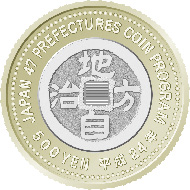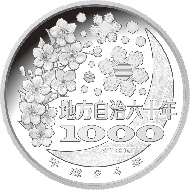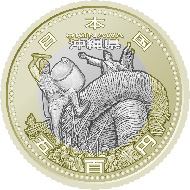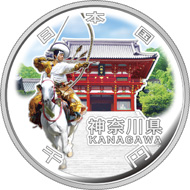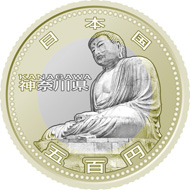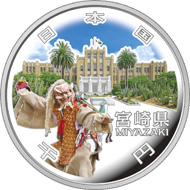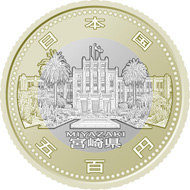March 22, 2012 – To mark the 60th Anniversary of Enforcement of the Local Autonomy Law, Japan Mint has launched “Japan 47 Prefectures Coin Program” in 2008. In this program, scheduled until 2015, two coins are dedicated to all 47 Prefectures of the country, a 1,000 Yen silver coin (available in proof quality) and a 500 Yen bi-colour clad coin (available in proof, BU and circulation quality).
Reverses.
All coins of this series share a common reverse design featuring snow crystals, moon and cherry blossoms on the silver coin and the shape of the old Japanese coins on the 500 Yen coin.
This year Japan Mint honours three prefectures: Okinawa, Kanagawa and Miyazaki. The coins will be available around May to June. Strong demand in Japan is expected, thus it might be difficult for non-Japanese collectors to get specimens of the new issues.
Silver coin “Okinawa”: Shuri Castle and Kumiodori.
The Okinawa silver coin shows on the individually designed obverse “Shuri Castle and Kumiodori”. The State Hall in Shuri Castle is known as the largest wooden building in Okinawa and was restored to its original state in 1992. Kumiodori, literally meaning combination dance, is traditional Okinawan musical theatre which composes of words, music, movements and dances. Okinawa was an independent country called Ryukyu Kingdom in the old days and developed its unique culture. Site of Shuri Castle, built in the end of 14th century, was registered in the UNESCO world heritage in December 2000 and Kumiodori, premiered in 1719) also was registered in the UNESCO intangible cultural heritage in November 2010.
Okinawa Prefecture is composed of around 50 manned islands and many uninhabited islands and located in the southwest and west terminus of Japan with a warm climate all the year around.
Bi-colour clad coin “Okinawa”: “Naha Giant Tug-of-War” and “Eisa folk dance”.
The bi-colour clad coin dedicated to Okinawa gives an impression of the “Naha Giant Tug-of-War” and “Eisa folk dance”. Naha Giant Tug-of-War originates in the middle of 15th century. In recent years, to wish for civil reconciliation, sound health and peace, the large scale rope, which is 186 meter length, 40 ton weight, 1.58 meter diameter, is tugged by fifteen thousand people. Eisa folk dance is performed by young men and women in the town to wish for sound health, safety of the family and prosperity and to hold a memorial service for ancestor’s soul from August to September.
Kanagawa, the second largest population prefecture after Tokyo, is located in the south of Tokyo and composes the metropolitan area.
Silver coin “Kanagawa”: Tsurugaoka Hachimangu Shrine and Yabusame.
The Kanagawa silver coin features the “Tsurugaoka Hachimangu Shrine in Samurai’s ancient city Kamakura and horseback archery called Yabusame”. Kamakura was a center of samurai government and Tsurugaoka Hachimangu Shrine was built in the later 12th century to protect the shogunate.
Yabusame is a type of mounted archery in traditional Japanese archery. An archer on a running horse shoots arrows at targets. This event at Tsurugaoka Hachimangu Shrine is held in Hojo-e ceremony, which respects to living creatures, and dedicated as a shrine ritual.
Bi-colour clad coin “Kanagawa”: “Great Buddha of Kamakura”.
The correspondent 500 Yen coin has as obverse theme the “Great Buddha of Kamakura, a designated National Treasure”. Under the idea of nation protection which wishes for peace both by the Kamakura shogunate and people, it is said that this Great Buddha was constructed by people with willingness under the leadership of shogunate as a symbol of samurai government and guardian Buddha.
The last of the three new coins is dedicated to Miyazaki, a province located in the southeast of the Kyusyu Island, with an atmosphere of tropical climate.
Silver coin “Miyazaki”: “Main Building of Miyazaki Prefectural Government and
Takachiho Yokagura”.
The silver coin’s theme is “Main Building of Miyazaki Prefectural Government and Takachiho Yokagura”. The Main Building of Miyazaki Prefectural Government with modern Gothic is a symbolic architecture in Miyazaki. Takachiho Yokagura is sacred nighttime dances spread to the Takachiho region known as mythology of the descent to earth of the grandson of the sun goddess. Every year from November to February, it is held at about twenty districts in the town. Thirty-three programs are performed throughout the night.
“Main Building of Miyazaki Prefectural Government and Takachiho Yokagura”.
Also the bi-colour clad coin features an impression of the “Main Building of Miyazaki Prefectural Government and Takachiho Yokagura” in the field.
Later this year three other coins will follow being dedicated to the Prefectures of Tochigi, Hyogo and Oita.
Further information on the Japan Mint’s Prefecture programme is available here.
Admire ability and concentration of the members of Takeda Ryu performing yabusame and an archery practice at the Meiji shrine.
Another clip gives an idea of what the dance Takachiho Yokagura is like.
To see the sacred dance of Kumiodori and learn more about its history, please click here.
This was the Okinawa Giant Tug-of-War in 2010! Incredible …





